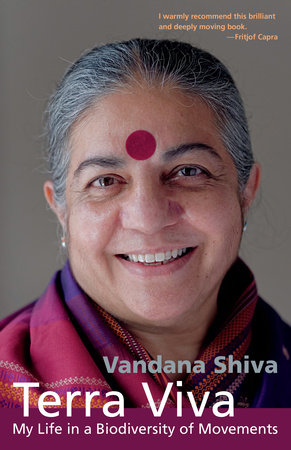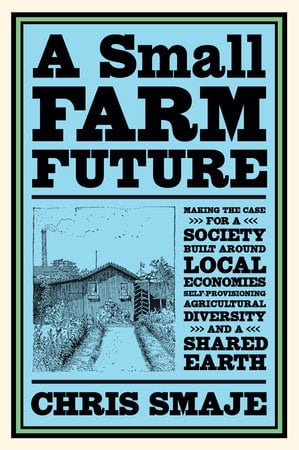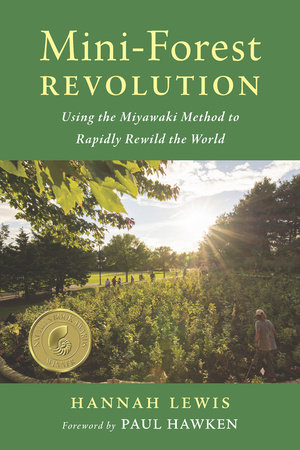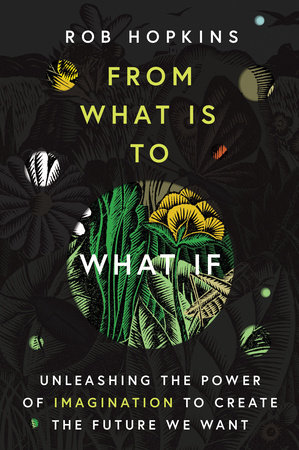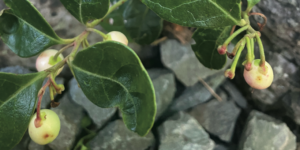Vandana Shiva’s Beginnings: An Icon In the Making
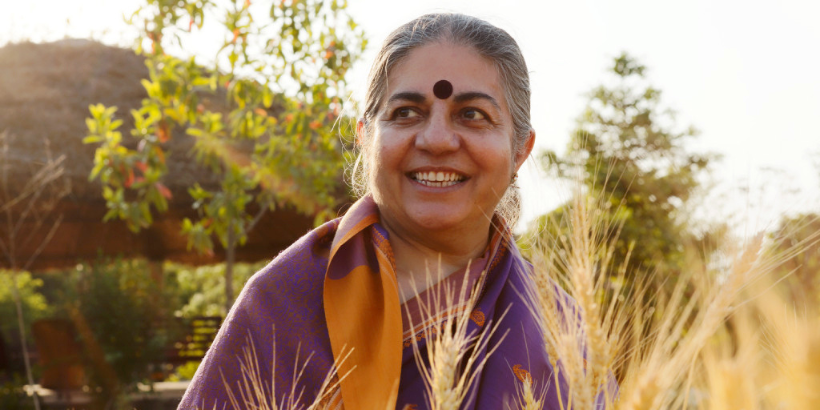
“All of us who care about the future of Planet Earth must be grateful to Vandana Shiva.”—Jane Goodall, UN Messenger of Peace
Dr. Vandana Shiva is a world-renowned environmental thinker and activist, leader of several forums and movements, twenty-time international award recipient, author and editor of a score of influential books, and a tireless crusader for farmers’, peasants’, & women’s rights. So how did she get here? How did Dr. Vandana Shiva become the inspiration she is today?
In her new book, Terra Viva, Dr. Shiva recounts the stories of her childhood in post-partition India and shared the influence they’ve had on her lifestyle & her work for the very first time.
The following is an excerpt from Terra Viva: My Life in a Biodiversity of Movements by Vandana Shiva. It has been adapted for the web.
The Start of “Shiva”
I was born in the doon valley in 1952, to a father who had become a forest conservator after leaving the army and a mother who had become a farmer after leaving a senior government job in education. My parents had met during the war, and when my father proposed to my mother she agreed to marry him if he eventually left the army and if she could continue to work. They also decided to give up their caste name as part of the anti-caste movement, which was a very significant part of our independence struggle, and adopted the caste-neutral Shiva. Mother was posted in what became Pakistan after the tragic partition of India in 1947; she survived miraculously, but she had become a refugee. Refugees of Partition were rehabilitated – shopkeepers got shops, employees got jobs, farmers got land. Instead of taking up a government job equivalent to what she had lost, my mother decided to get rehabilitated as a farmer.
I was born five years after Partition, and my childhood was shaped by the forests in the Himalaya where my father was posted and by my mother’s farm in the foothills. Nature was my first inspiration – and the study of nature my first passion – which is how I ended up becoming a physicist.
My most intimate memories of childhood are the sights and sounds, tastes and smells of the Himalayan forests where I grew up; they became my physical and intellectual cradle. I feel a deep umbilical connection to forests of rhododendron, oak and deodar, and to mountain streams. We lived in Chakrata when I was born and later moved to Nainital, Pithoragarh, Tehri, Uttarkashi and Dehradun, which my parents decided to make their home. Today, these Himalayan regions are an independent state called Uttarakhand (the mountain state).
History of Himalayan Regions
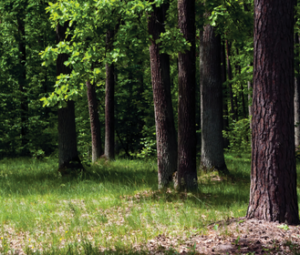
The contradictions between people’s basic needs and the state’s revenue requirements, however, remained unresolved, and in due course these contradictions intensified. In 1930, the people of Garhwal launched the non-cooperation movement to draw attention to the issue of forest resources; forest satyagrahas to resist oppressive forest laws were most intense in the Rawain region. The king of Tehri was in Europe at that time; in his absence, Dewan Chakradhar Jayal resorted to armed intervention to crush a peaceful satyagraha at Tilari. A large number of unarmed satyagrahis were killed and wounded, while others lost their lives in a desperate attempt to cross the rapids of the Yamuna river. Years later, the martyrs of the Tilari massacre provided inspiration to the Chipko movement, when people pledged themselves to protect their forests.
Vandana & The Chipko Movement
There were very few roads in the Himalaya when I was growing up, so most of our journeys took place on foot or on horseback. As a forest conservationist, my father’s job was to inspect and manage forests and regenerate them. During all our vacations we joined him on his tours. Our ‘rations’ would travel in huge boxes laden on mules, and there would always be another box full of books. We lived like nomads, far away from cities, amidst the wealth of the forest. This experience has clearly influenced my thinking about wealth and poverty; for me, the forests of my childhood were the source of abundance and beauty, diversity and peace. With my sister, I would collect ferns to turn into works of art; wildflowers were our pearls and diamonds. That is why when the forests started to disappear, I joined the Chipko movement to protect them.
The Chipko movement is historically, philosophically and organisationally an extension of the traditional Gandhian satyagraha. Its special significance lies in the fact that it took place in post-Independence India; the continuity between the pre-Independence and post-Independence forms of this satyagraha was provided by Gandhians, including Sri Dev Suman (1), Mira Behn (2), and Sarala Behn (3). Equipped with the Gandhian worldview of development based on justice and ecological stability, they contributed silently to the growth of woman power and ecological consciousness in the hill areas of Uttar Pradesh. The influence of Mira Behn and Sarala Behn, the two European disciples of Gandhi, on the struggle for social justice and ecological stability in the hills of Uttar Pradesh has been immense – they generated a new breed of Gandhian activists who laid the foundation for the Chipko movement. Sunderlal Bahuguna (4) is prominent among this new generation, deeply inspired by Mira Behn and Sarala Behn. In an article written in 1952, Mira Behn had stated that there was ‘Something Wrong in the Himalaya.’ She had identified not merely deforestation but change in species suitable to commercial forestry as the reason for ecological degradation in the Himalayas. [Mira] recognised that the leaf litter of oak forests was the primary mechanism for water conservation in mountain watersheds.
Mira Behn and Sarala Behn were frequent visitors to our home. Sunderlal Bahuguna and Bimla Bahuguna (5), too, came to meet my parents, and Ghanshyam Raturi (Shailani), the legendary Chipko poet, would spend hours with my mother, reciting his new songs. Our home was open house for social activists, poets and intellectuals; its stimulating environment must have been part of the informal education that made ecological values and values of social and economic equality basic to my life and work.
In 1972, women in a high-altitude village, Reni, blocked logging operations by wrapping their arms around the trees, giving birth to the Chipko (literally, to cling) movement. The name was given to the movement by Raturi, who composed folk songs which were sung by every child, woman and man in Garhwal.
Nineteen seventy-two witnessed the most widespread organised protests against commercial exploitation of Himalayan forests by outside contractors – in Uttarkashi on December 12, and in Gopeshwar on December 15.
Saving Forests & Building Momentum

During the next five years, Chipko resistance spread to various parts of the Garhwal Himalaya. It is important to note that it was no longer the old demand for the supply of forest products to local small industries, but a new one for ecological control of forest resource extraction to ensure a supply of water and fodder that was being aired. Among the numerous examples of Chipko’s successes throughout the Garhwal Himalaya in the later years are those in the Adwani, Amarsar and Badiyargarh forests. The Adwani forests were scheduled to be felled in the first week of December 1977. Large groups of women led by Bachhni Devi came forward to save the trees. (Interestingly, Bachhni Devi was the wife of the local village head, who was himself a contractor.) Chipko activist Dhoom Singh Negi8 supported the women’s struggle by undertaking a fast in the forest; women tied sacred threads to the trees, symbolising their vow of protection. Between December 13 and 20, a large number of women from fifteen villages guarded the forests, while discourses from ancient texts on the role of forests in Indian life continued non-stop. It was here in Adwani that the ecological slogan ‘What do the forests bear? Soil, water and pure air’ was born.
The axe-men withdrew, only to return on February 1, 1978, with two truckloads of armed police. The plan was to encircle the forests with the help of the police, in order to keep the people out during the felling operation. Even before the police reached the area, volunteers of the movement entered the forest and explained their case to the forest labourers who had been brought in from distant places. By the time the contractors arrived, each tree was being embraced by three volunteers. The police, seeing the level of awareness among the people, hastily withdrew before nightfall.
In March 1978, a new auction was planned in Narendranagar. A large popular demonstration was organised against it and the police arrested twenty-three Chipko volunteers, including women. In December 1978, a massive felling programme was planned by the public sector undertaking, the Uttar Pradesh Forest Corporation, in the Badiyargarh region. The local people immediately informed Bahuguna who began a fast unto death at the felling site in January 1979. On the eleventh day of his fast he was arrested in the middle of the night; this only served to strengthen the commitment of the people. Ghanshyam Raturi and a priest, Khima Shastri, led the movement as thousands of men and women from neighbouring villages joined them in the Badiyargarh forests. The people guarded the trees for eleven days, after which the contractors finally withdrew. Bahuguna was released from jail on January 31, 1979.
The cumulative impact of sustained grassroots struggles to protect forests resulted in a rethinking of forest management in the hill areas. The Chipko movement’s demand for declaring the Himalayan forests as ‘protection’ forests instead of ‘production’ forests for commercial exploitation was recognised at the highest policy-making level. The then prime minister, Indira Gandhi, after a meeting with Bahuguna, recommended a fifteen-year ban on commercial green felling in the Himalayan forests of Uttar Pradesh.
The moratorium on green felling gave the Chipko movement breathing time to expand its base, and Bahuguna undertook a 4,780 km long, arduous march from Kashmir to Kohima in Nagaland, contacting villagers along the long Himalayan range and spreading the message of Chipko. At the same time, activists found it opportune to take the movement to other mountain regions in the country.
Switching Gears: From Quantum Physics to Activism
I decided in 1974 that, while pursuing my PhD in quantum theory, I would volunteer with Chipko every vacation. And that is what I did.
Chipko was clearly my university for ecology. While my parents provided the embedding in a forest culture and an appreciation of natural mixed forests, it was Chipko that made me realise, in intimate detail, how biodiversity is at the heart of sustainable economies and how nature provides for the basic needs of the large majority in the world. As I worked with peasant women, transferring fertility from the forest to the field, I learnt my first lessons in organic farming: sustainable societies rest on humus. In those early years, as I moved between quantum physics and protecting the Himalayan forests, I learnt to respect both the best of modern ecological science and the best of traditional knowledge. I developed a humility about my doctorate studies, recognising how much I did not know, and how much knowledge illiterate village women, with no formal education, had. That is why the term ‘knowledge society’ as a description of computer-based societies is so inaccurate and misleading to me, implying that non-industrialised, non-computerised societies are without knowledge. In the case of biodiversity, of forest species and plant species, this is clearly not true; women and indigenous communities, the excluded of the industrial world, are the real custodians of biodiversity-related knowledge.
Nuclear physics was my chosen speciality until I realised that the science had a dark side to it. I changed course to become a theoretical physicist and worked in foundations of quantum theory, fully expecting to stay on and become a professor, when I was confronted with the nagging thought that I wasn’t informed enough about how society works. We in India have the third largest scientific community in the world. We are among the poorest of countries. Science and technology are supposed to boost growth, remove poverty. So, where is the gap? I wanted to answer this question for myself, so I took three years off to look at science policy issues, be a little more educated socially, and then go back to physics. I went to the Indian Institute of Science and the Indian Institute of Management (IIM) in Bangalore, where I studied interdisciplinary research in science, technology and environmental policy.
After three or four years, what started as a look at policy issues became the focus of my life. Speeding me along a path that would ultimately lead to grassroots activism was my growing reputation as an authority in the field of environmental impact. I found myself learning more and more about the threat posed by biotechnology to biodiversity. In 1981, the Ministry of Environment invited me to study the effects of mining in the Doon valley. As a result of my report, the Supreme Court banned mining there in 1983. This was the first time I had done something professionally about conservation – it was not just an academic engagement divorced from action or consequences; I found it so fulfilling, working with communities and making a difference in society.
A Forward-Thinking Future

I realised during the great drought of 1984 in Karnataka that the very way we do agriculture is flawed. That year also saw the peak of militancy in Punjab. I wrote about the violence of the Green Revolution that gave rise to a non- sustainable form of agriculture, which was pretending to create more food but was actually destroying nature, farmers’ sense of self, and creating war within society. What was really a sustainability and democracy issue was politicised and communalised.
In 1987, during a meeting at the United Nations (UN), I thought, Mahatma Gandhi had used a charkha or spinning-wheel to spearhead satyagraha; I came up with the idea of the seed as an equivalent of the charkha for our modern satyagraha against the appropriation of agriculture by multinational corporations (MNCs). Navdanya was born in that moment of awareness, although it did not become a full- fledged organisation until 1991. The conservation farm was started about five years later with a view to inspire farmers to come and see two-hundred-and-fifty varieties of rice and eight-hundred species of plants growing in the same field.
When Satish Kumar, editor of Resurgence, asked me to set up something in India along the lines of Schumacher College, which he had co-founded in the UK, I hesitated because I preferred building movements to building buildings. But he convinced me that it was time for an institution like the Bija (seed) Vidyapeeth, and so we set up the Bija Vidyapeeth/Earth University in 2000 – mainly because it was going to be at the Navdanya farm, which was a seed bank, and also because a seed is an inspiration for renewal as well as an example of the small embodying the whole. The Bija Vidyapeeth really became a bija; instead of buildings, I could see the progression of a dialogue and mutual growth. And so we continued to hold courses with Schumacher College, and the best of people agreed to come and teach: the physicist Fritjof Capra; The Body Shop founder, Anita Roddick; and Satish himself.
Recommended Reads
History of The Seed Sovereignty Movement: Reclaiming the Seed
Recent Articles
You know of Dasher, Dancer, Prancer & Vixen. Comet, Cupid, Donner & Blitzen. Rudolph too! But have you heard of the Sámi people who herd reindeer in Norway?
Read MoreWintergreen is the stunning evergreen groundcover that’s a game-changer for your garden! It’s cherished for its aromatic leaves, vibrant fall color & bright berries.
Read MoreThe fig tree is more than just a fruit-bearing wonder. The complex nature of these trees is beyond fascinating. They are the ultimate ecosystem superheroes!
Read MoreThe dirty truth? Soil isn’t just dirt! It’s a complex web of life. Discover the secrets to unlocking its full potential and transform your garden forever.
Read MorePumpkins: Halloween symbol or sweet treat? But have you ever wondered how they became a holiday staple? Discover the rich history behind this fall favorite!
Read More

